The Image as Verb
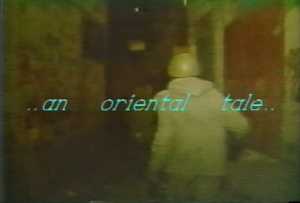 Introduction to the Ende of an Argument: (Intifada) Speaking for Oneself … Speaking for Others (Jayce Salloum and Elia Suleiman, 1990) (still)
Introduction to the Ende of an Argument: (Intifada) Speaking for Oneself … Speaking for Others (Jayce Salloum and Elia Suleiman, 1990) (still)
The following is an edited version of a conversation between Alaa Mansour and Philip Widmann which took place at the European Media Art Festival (EMAF) in Osnabrück on 22 April 2022. Alaa was invited to select a film for the programme strand Implication – On Documentary Ethics, in which the EMAF asked a number of filmmakers with films in competition to present a film addressing ethical questions related to the use of documentary methods or gestures in their own work.
Alaa selected INTRODUCTION TO THE END OF AN ARGUMENT: (INTIFADA) SPEAKING FOR ONESELF…SPEAKING FOR OTHERS…, a video work made by Lebanese-Canadian artist Jayce Salloum and Palestinian filmmaker Elia Suleiman in 1990, in which they “undo and redo history at a kinetic speed”, as she writes in her introduction. The conversation following the screening of INTRODUCTION links Salloum’s and Suleiman’s work to Alaa’s own film THE MAD MAN’S LAUGHTER, in which she examines the creation of a universal Arab enemy in the context of the US invasion of Iraq in 2003, its prehistory and aftermath. Here, digital technology serves to establish new speculative types of evil.
 Introduction to the Ende of an Argument: (Intifada) Speaking for Oneself … Speaking for Others (Jayce Salloum and Elia Suleiman, 1990) (still)
Introduction to the Ende of an Argument: (Intifada) Speaking for Oneself … Speaking for Others (Jayce Salloum and Elia Suleiman, 1990) (still)
This conversation took place two months after the Russian invasion of Ukraine. There, similar essentializations, demonizing or belittling Ukrainians and denying the historical legitimacy of the Ukrainian state, end any argument and justify the “special operation” that this outright imperialist war has been cloaked as. They are part of media strategies, which are countered by equally strategic, and admittedly often more convincing and more easily justifiable audiovisual operations on the side of the perpetrated. The current war and its media components were not a subject of the conversation, their hum, however, was clearly audible in the background.
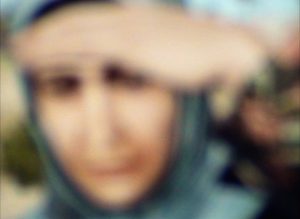 The Mad Man’s Laughter (Alaa Mansour, 2021) (still)
The Mad Man’s Laughter (Alaa Mansour, 2021) (still)
In response to the call for Rosa Mercedes 05 – Against “Special Operation” Images, we have decided to edit the transcript of this conversation. The problematization of essentializations’ epistemic functions and the artistic repurposement of violent imagery and images of violence in both INTRODUCTION and THE MAD MAN’S LAUGHTER are pertinent beyond the geographical and historical contexts that the films refer to. No act of violence is comparable to another, and the suggestion of common or related causes of dispersed acts of violence turns their victims into statistical figures within a larger calculation involving unfathomable powers. Rather than sidetracking our attention from current atrocities and suffering, then, the question of who is speaking (seeing and presenting) for and to whom, from which position and on whose account, which INTRODUCTION reiterates relentlessly, appears to be central to any assessment and attempt at de-fusion of the operationality of audiovisual media on behalf of their consumers, who are prone to become producers and disseminators themselves.
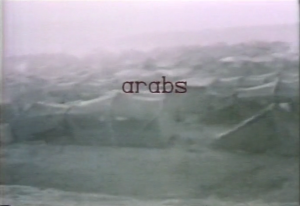 Introduction to the Ende of an Argument: (Intifada) Speaking for Oneself … Speaking for Others (Jayce Salloum and Elia Suleiman, 1990) (still)
Introduction to the Ende of an Argument: (Intifada) Speaking for Oneself … Speaking for Others (Jayce Salloum and Elia Suleiman, 1990) (still)
Alaa Mansour: I’m really humbled to present to you today the brilliant INTRODUCTION TO THE END OF AN ARGUMENT (INTIFADA) – SPEAKING FOR ONESELF, SPEAKING FOR OTHERS, by Canadian-Lebanese filmmaker Jayce Salloum and Palestinian filmmaker Elia Suleiman. This film was released in 1990, but made in the context of what is known as the first Palestinian intifada of 1987. I’ve chosen to show you this film today because it’s a work that emphasizes the historical construction of the image of “the Arab” in Western media and cinema. It confronts these dominant representations. For me, this film is an invitation to challenge our perceptions and reclaim an agency over the image, its historical and political implications.
Something that is very appealing in this film is its structure. There is no beginning, no middle, no end. I feel that it mimics the whole “Israeli-Arab conflict”, as it has been phrased from a Western point of view. So for me, this film is actually very current today. It never ceased to be this way. Salloum tackles the notion of “non-naming” as much as “naming” itself, both being tools of epistemological violence. Here, violence stands for abstracting “the Arab”, keeping it in anonymity or, on the contrary, for actually molding “the Arab” as a “terrorist”.
INTRODUCTION TO THE END OF AN ARGUMENT … excerpt
These are the main issues that made me decide to present to you this film in the context of Implication – On Documentary Ethics, but also in relation to my own practice. For those who are going to watch my film THE MAD MAN’S LAUGHTER later this afternoon, you’ll have direct access to connections I built between both works. THE MAD MAN’S LAUGHTER explores the construction of the “universal enemy” as a concept, but also literally, through an essentialization of this “enemy” and consequently “its” silencing. I think INTRODUCTION gives a voice to the voiceless in that sense.
Jayce Salloum went to Palestine for the first time in 1988. He shot some of the footage seen in the film. This is when he met with Elia Suleiman, who at the time wasn’t a well known filmmaker. INTRODUCTION was their first collaboration, in which they treated the material Salloum had shot in Palestine as found footage. The whole film is a montage of found footage that weaves the path to an outside: How could one talk about, and which name could one give to this history outside of the dominant representations and viewpoints?
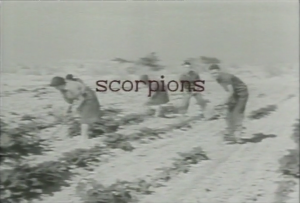 Introduction to the Ende of an Argument: (Intifada) Speaking for Oneself … Speaking for Others (Jayce Salloum and Elia Suleiman, 1990) (still)
Introduction to the Ende of an Argument: (Intifada) Speaking for Oneself … Speaking for Others (Jayce Salloum and Elia Suleiman, 1990) (still)
Philip Widmann: While watching INTRODUCTION again, I was thinking that the notion of ethics cannot be answered normatively, but only in relational terms. If it means taking a position towards something and reflecting on this position, then INTRODUCTION, taking a position towards pre-existing images and their effects in the real world, appears to be primarily concerned with ethics. It is also in a relational sense that the film can be situated historically. As you mentioned, it was produced in response to the “first” intifada. Also, it was released around 12 years after the first edition of Edward Said’s Orientalism was published, whose inquiry into the representational regime that occidental powers imposed on “the East” must have been widely read and re-read at this point of time. At the very beginning of the book, Said had put a quote from Marx’ Eighteenth Brumaire of Louis Bonaparte: “They cannot represent themselves; they must be represented.”
“They” are the small peasants in mid-19th century France. Representation, in this case, means political representation. But of course, the term also relates to giving names, to making images, to the formation of assumed entities or collectivities through language and visual media. These peasants were considered not to be able to represent themselves politically, so they would eventually bring a new authoritarian leader to power, Napoleon III. But they were also visually represented in picturesque painting by people from another class, who remain as invisible in these pictures as Bonaparte remains out of reach of parliamentary control and “the people”. Something similar happens in Orientalism, in both meanings of “representation”. Orientalist painting depends on the notion of the picturesque, its reduction of people to types, of land to landscape, of labor to folklore, and the invisibility of those who forge this gaze. Orientalist politics, on the other hand, depends on the notion of people who are unable to develop effective ways of governing themselves, to use the resources of the land they live on or to gain knowledge from history.
INTRODUCTION TO THE END OF AN ARGUMENT … excerpt
AM: I would add that there are too many images of this place, this place that also has too many names: the Arab world, the Muslim world, the Levant, the Near East, the Middle East. All of these aren’t ours as Arabs, and we fall into these constructions as well. I feel that there is a dialectical opposition between the villain Arab and the rational West, the latter being the entity entitled to speak about the Arab world. Also, I feel that the idea of being able to speak for ourselves is one we’ve been dispossessed from. This is a major point of this film. As if the ability to speak about ourselves requires that we make use of a prefigured argumentative methodology. But it doesn’t succeed.
INTRODUCTION TO THE END OF AN ARGUMENT … excerpt
PW: You mean an argumentative way that is sanctioned by “the West”? Both in the context of INTRODUCTION and your own work, I was wondering what the role of diasporic identities is when one tries to interject into these pre-existing images and their accompanying phrases? Where one speaks from does partly determine what one can say and how, but also for and to whom. As far as I know, Jayce Salloum was born in Canada. His grandparents were Syrians from the Bekaa Valley in today’s Lebanon. Elia Suleiman was born in Nazareth and lived in New York when they worked on INTRODUCTION. I know that you’ve been living in France for 16 years and that you’ve recently moved back in Lebanon. How does this aspect relate to your own practice: where you are speaking from, making and processing images from?
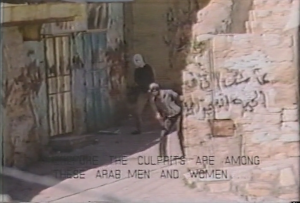 Introduction to the Ende of an Argument: (Intifada) Speaking for Oneself … Speaking for Others (Jayce Salloum and Elia Suleiman, 1990) (still)
Introduction to the Ende of an Argument: (Intifada) Speaking for Oneself … Speaking for Others (Jayce Salloum and Elia Suleiman, 1990) (still)
AM: Well, being part of this diaspora, one thing that essentializes us “Arabs” is always being identified as such. I, for instance, never introduce myself as a Lebanese or Arab filmmaker. And I feel that being outside of this war-torn region, the Middle East, has given me the ability to put myself at a distance and maybe to also to liberate myself from all these constructions that we have come to acknowledge as true. It is actually difficult to compare Lebanon to Palestine today since the Israeli occupation of the Palestinian territory inflicts impervious logistical and militaristic realities that make it difficult for Palestinians to make and distribute films locally as they please.
For sure, the fact that Salloum and Suleiman were residing outside of Palestine helped in making this film a reality. But the scale of distance shouldn’t only be measured geographically, it should also be observed from an epistemological and discursive vantage point. Therefore the “outside” translates as a liberation from occupational imaginaries and representations forcibly potent and alienating.
Looking into the historicization of INTRODUCTION in relation to the “first” Palestinian intifada, I would like to emphasize that Palestinians were already resisting the colonial British occupation forces, Zionist militias and settlers back in the 1930s. It’s an important point to underline because it shows once more that the course of events is defined from the outside using the same binary governing rhetoric. Not only does the West define a biased description of the “events”, it also instigates a thoroughly orchestrated falsification of the “events”. On another note, the cinema industry in the Arab world also played a role in disseminating prototyped forms and contents since it has always been dependent on the western economy and industry. This also implies that we are represented as the producer wants us to be represented. This fact has contributed in shaping this image of “the Arab” throughout the history of cinema. And of course, with the introduction of television, the media coverage of the conflicts played a really important role in that sense.
INTRODUCTION TO THE END OF AN ARGUMENT … excerpt
PW: INTRODUCTION mostly employs images produced by corporations throughout the 20th century, until the late 1980s. The second to last shot, showing people on a platform seen from a train leaving, is by a Lumière operator. It’s probably one of the first moving images made in Palestine. So the film covers almost the whole 20th century and its global circulation of images made by corporate entities.
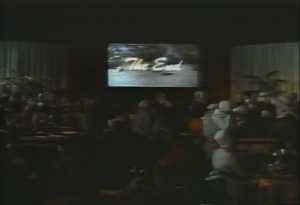 Introduction to the Ende of an Argument: (Intifada) Speaking for Oneself … Speaking for Others (Jayce Salloum and Elia Suleiman, 1990) (still)
Introduction to the Ende of an Argument: (Intifada) Speaking for Oneself … Speaking for Others (Jayce Salloum and Elia Suleiman, 1990) (still)
With the start of the internet age from the late 1990s onwards, it is not only corporations anymore that put images in global circulation, but also people like you and me, artists and non-artists alike. What I want to say is: Jayce Salloum and Elia Suleiman appropriate images made by corporations as individual artists and recirculate them in the form of a video art piece. I think that at the point when the work was made, it must have been easier to disassociate oneself from the supposed origin of these images than it is today. I feel it has become more difficult to locate the origin of those images within the realm of a somewhat obscure Western, imperialist, colonial and capitalist power. In your current work, THE MAD MAN’S LAUGHTER, you work with images that are around on the internet or that come from AI engines. How do you position yourself to the supposed origin of those images, or to the supposed power that creates those images?
AM: I’d start by pointing out the ambivalent relation to archival objects which we, as artists, art researchers and practitioners, tend to perpetuate.
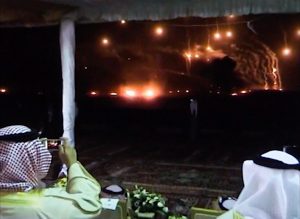 The Mad Man’s Laughter (Alaa Mansour, 2021) (still)
The Mad Man’s Laughter (Alaa Mansour, 2021) (still)
Besides the abundant circulation of archival-based (found footage) works in the artistic sphere—which comes merely accompanied by an in-depth assessment of what is an “archive” (especially in today’s world/era), there is a fetishization of the material itself that goes beyond Edward Said’s Orientalism, in the sense that the archival object is often regarded as sacred, as an “on-display” item that must stay untouched. In my work I look at archival objects as I would if I could stab them with my own gaze. To be able to go through a deconstructive process, I begin with desacralizing the material and my relation to it, acknowledging the power it holds and the power of its holder. As a beholder, but also as a maker, I can but only scratch the surface and investigate the image and the medium themselves, and learn about their context of production and circulation. What unfolds isn’t only an “ontology” of the archival object we’re encountering, but also its encapsulated subtext. This approach is about reactivating archival objects as much as disrupting their historical path and political signification.
INTRODUCTION TO THE END OF AN ARGUMENT … excerpt
Salloum uses the term “counterance” to describe the gesture at work in INTRODUCTION. Countering the archive by resisting to its inherent praxis, which is forging and perpetuating a nation’s narrative, a collective imaginary. In the case of THE MAS MAN’S LAUGHTER, I prospect the archetypal textual and visual language of the political and the machine, and explore “what comes after the image”. This is a question that goes beyond the language of simulation if we look at how today’s artificial intelligence has become substantially self-learning, auto-producing knowledge, and is generating all kinds of imageries and contents. The diversity of the material I collected throughout the making of the film was made possible because of the unorthodox tools put at use to actually find and save part of it.
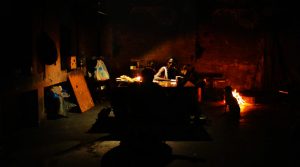 The Mad Man’s Laughter (Alaa Mansour, 2021) (still)
The Mad Man’s Laughter (Alaa Mansour, 2021) (still)
In that sense, diving into open source intelligence is a counter-power, a “counterance”, in the face of opaque and invisible spheres of powers, especially if this data is shared publicly, making it accessible to those who “don’t know” or “cannot/don’t want to see” with their own eyes. Here, the data pointed at refers to sensitive governmental and military content, either leaked, declassified or openly accessible online. In that sense, I’d say that data itself has become history today. Manipulating this data and feeding it to the machine (i.e Artificial Intelligence/Machine Learning/Computation) can be a powerful tool for deconstructing and reshaping history.
In my film, I specifically used AI to generate a fictive persona that would impersonate the figure of the “universal enemy”. The dataset of images that I used to train the model was scrapped from various search engines through which I looked for keywords such as “Arab”, “muslim” and “terrorist”. This ability to generate an active counter-visuality and a counter-history is made easier with the currently accessible technologies, through which one can model powers disruptions.
PW: Steve Seid from Pacific Film Archives once wrote that in his view INTRODUCTION was the first attempt at making the image and the act one and the same. The same could be said about THE MAD MAN’S LAUGHTER, which is very much about the agency of images, especially when they’re supposedly produced by an artificial intelligence. There seems to be always some aspect of them which spins out of your control.
AM: I like this idea of an image being a verb—an act as you mentioned it. It’s also—and this can be connected to what I said about desacralizing the image or the archive—, it’s not about being completely in control of an image or being completely submissive to an image either, but it’s about trying to actually create a conflict within the image itself as Eisenstein would have put it. I feel this film is very much about the conflict in montage and how to intentionally invite conflict in montage. And maybe this is a way of acting.
PW: I felt that INTRODUCTION is returning the insult.
AM: Returning the insult?
PW: Because it’s reducing the supposed makers of those images to protagonists of a parody just as much as “the Arab” is being reduced in the images that they supposedly make of them. It’s a counter polemic.
AM: Yes, it is. And it’s also—this is something that Jayce Salloum really underlines as well—, it’s the idea of the “unrepresentable”. Unrepresentable because of it being oversaturated. And emptied from its meaning as well. So, I think in that sense he tried to also transform the West into something unrepresentable, especially in the repetitions, this absurdity that is the United Nations, and all the resolutions that never were applied or came to reality. So yes, I would say it’s also a way of (re)turning the West into this fiction.
INTRODUCTION TO THE END OF AN ARGUMENT … exzerpt
All excerpts taken from INTRODUCTION TO THE END OF AN ARGUMENT: (INTIFADA) SPEAKING FOR ONESELF…SPEAKING FOR OTHERS… by Jayce Salloum and Elia Suleiman. The complete version can be found here. Alaa Mansour’s THE MAD MAN’S LAUGHTER can be watched here.
17.01.2023 — Rosa Mercedes / 05